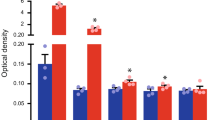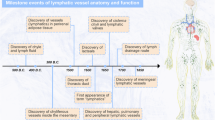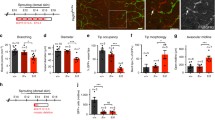Abstract
The lymphatic vessels can be selectively stimulated to grow in adult mice, rats and pigs by application of viral vectors expressing the lymphangiogenic factors VEGF-C or VEGF-D. Vice versa, lymphangiogenesis in various pathological settings can be inhibited by the blocking of the VEGF-C/VEGFR3 interaction using a ligand-binding soluble form of VEGFR3. Furthermore, the recently discovered plasticity of meningeal and lacteal lymphatic vessels provides novel opportunities for their manipulation in disease. Adenoviral and adeno-associated viral vectors (AAVs) provide suitable tools for establishing short- and long-term gene expression, respectively and adenoviral vectors have already been used in clinical trials. As an example, we describe here ways to manipulate the meningeal lymphatic vasculature in the adult mice via AAV-mediated gene delivery. The possibility of stimulation and inhibition of lymphangiogenesis in adult mice has enabled the analysis of the role and function of lymphatic vessels in mouse models of disease.
Access this chapter
Tax calculation will be finalised at checkout
Purchases are for personal use only
Similar content being viewed by others
References
Karaman S, Aspelund A, Detmar M, Alitalo K (2017) The lymphatic system. In: Krams J, Back M (eds) The ESC textbook of vascular biology. Oxford University Press, Oxford
Alitalo K (2011) The lymphatic vasculature in disease. Nat Med 17(11):1371–1380. https://doi.org/10.1038/nm.2545
Petrova TV, Koh GY (2018) Organ-specific lymphatic vasculature: from development to pathophysiology. J Exp Med 215(1):35–49. https://doi.org/10.1084/jem.20171868
Nurmi H, Saharinen P, Zarkada G, Zheng W, Robciuc MR, Alitalo K (2015) VEGF-C is required for intestinal lymphatic vessel maintenance and lipid absorption. EMBO Mol Med 7(11):1418–1425. https://doi.org/10.15252/emmm.201505731
Antila S, Karaman S, Nurmi H, Airavaara M, Voutilainen MH, Mathivet T, Chilov D, Li Z, Koppinen T, Park JH, Fang S, Aspelund A, Saarma M, Eichmann A, Thomas JL, Alitalo K (2017) Development and plasticity of meningeal lymphatic vessels. J Exp Med 214(12):3645–3667. https://doi.org/10.1084/jem.20170391
Louveau A, Plog BA, Antila S, Alitalo K, Nedergaard M, Kipnis J (2017) Understanding the functions and relationships of the glymphatic system and meningeal lymphatics. J Clin Invest 127(9):3210–3219. https://doi.org/10.1172/JCI90603
Colella P, Ronzitti G, Mingozzi F (2018) Emerging issues in AAV-mediated in vivo gene therapy. Mol Ther Methods Clin Dev 8:87–104. https://doi.org/10.1016/j.omtm.2017.11.007
Paxinos G (2013) Paxinos and Franklin’s the mouse brain in stereotaxic coordinates. Elsevier/Academic Press, Boston
Anisimov A, Alitalo A, Korpisalo P, Soronen J, Kaijalainen S, Leppänen V-M, Jeltsch M, Ylä-Herttuala S, Alitalo K (2009) Activated forms of VEGF-C and VEGF-D provide improved vascular function in skeletal muscle. Circ Res 104(11):1302–1312. https://doi.org/10.1161/CIRCRESAHA.109.197830
Fang S, Nurmi H, Heinolainen K, Chen S, Salminen E, Saharinen P, Mikkola HK, Alitalo K (2016) Critical requirement of VEGF-C in transition to fetal erythropoiesis. Blood 128(5):710–720. https://doi.org/10.1182/blood-2015-12-687970
Alitalo AK, Proulx ST, Karaman S, Aebischer D, Martino S, Jost M, Schneider N, Bry M, Detmar M (2013) VEGF-C and VEGF-D blockade inhibits inflammatory skin carcinogenesis. Cancer Res 73(14):4212–4221. https://doi.org/10.1158/0008-5472.CAN-12-4539
Acknowledgment
We gratefully acknowledge funding by the Jane and Aatos Erkko Foundation, European Research Council (ERC) under the European Union’s Horizon 2020 research and innovation program under grant agreement No 743155, the Wihuri Research Institute maintained by the Jenny and Antti Wihuri Foundation, the Academy of Finland Centre of Excellence Program 2014–2019 (307366), the Fondation Leducq, the Novo Nordisk Foundation and the Sigrid Jusélius Foundation (all to K.A.). S.K. was supported by the Swiss National Science Foundation (Advanced Postdoc.Mobility grant number: P300PB_164732), Orion Research Foundation, Finnish Foundation for Cardiovascular Research and the Maud Kuistila Memorial Foundation. H.N. was supported by Finnish Cultural Foundation, Paulo Foundation and Orion Research Foundation. S.A. was supported by Biomedicum Helsinki Foundation, Finnish Medical Foundation and Duodecim, Orion Research Foundation, Finnish Cultural Foundation, the Eemil Aaltonen Foundation and Aarne Koskelo Foundation.
Author information
Authors and Affiliations
Corresponding author
Editor information
Editors and Affiliations
Rights and permissions
Copyright information
© 2018 Springer Science+Business Media, LLC, part of Springer Nature
About this protocol
Cite this protocol
Karaman, S., Nurmi, H., Antila, S., Alitalo, K. (2018). Stimulation and Inhibition of Lymphangiogenesis Via Adeno-Associated Viral Gene Delivery. In: Oliver, G., Kahn, M. (eds) Lymphangiogenesis. Methods in Molecular Biology, vol 1846. Humana Press, New York, NY. https://doi.org/10.1007/978-1-4939-8712-2_19
Download citation
DOI: https://doi.org/10.1007/978-1-4939-8712-2_19
Published:
Publisher Name: Humana Press, New York, NY
Print ISBN: 978-1-4939-8711-5
Online ISBN: 978-1-4939-8712-2
eBook Packages: Springer Protocols




